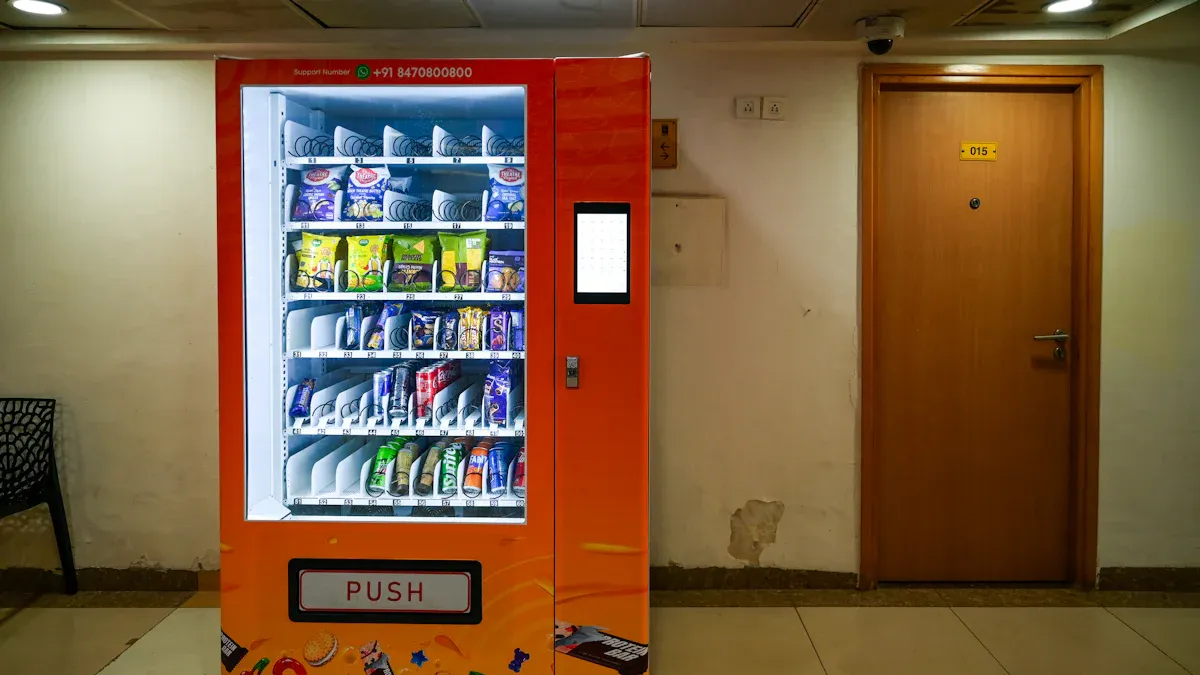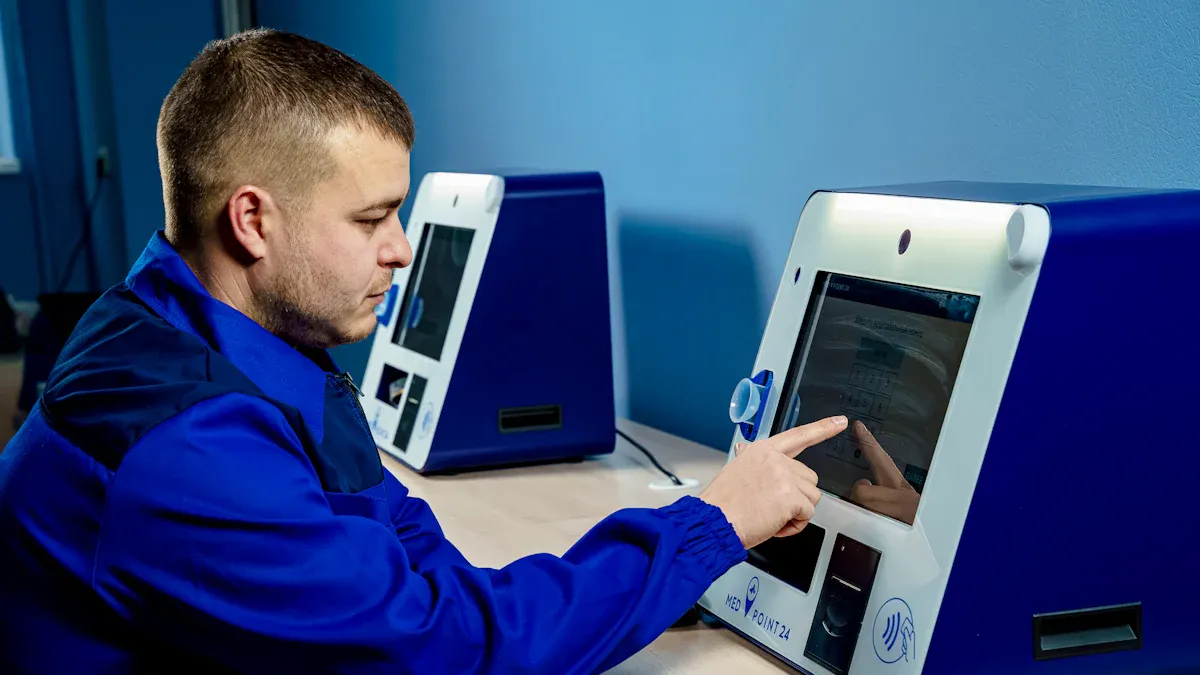How Vending Machine Automation Is Shaping Retail Innovation

Retailers are seeing fast changes as vending machine automation grows everywhere. The global market will be $18.6 billion by 2025 and $51.3 billion by 2035.
Year | Market Value (USD) | CAGR (%) |
|---|---|---|
2025 | 18.6 billion | 10.1 |
2035 | 51.3 billion |
Cashless payments and real-time inventory management help stores give faster service. These tools also help stores keep more products in stock. Many people think vending machines only sell snacks or are hard to take care of. But modern machines now offer many different products. They use smart technology to make shopping better for customers.
Key Takeaways
Vending machine automation is growing fast. The market may reach $51.3 billion by 2035. This gives retailers new chances to grow.
Smart vending machines sell many things, not just snacks. They offer electronics and health supplies too. This gives customers more choices.
Cashless payments are common now. They make buying things quicker and safer. This helps customers feel happy and stores work better.
Real-time inventory management helps stores keep popular items ready. It cuts down on waste and helps stores earn up to 38% more money.
New features like personalized tips and interactive screens make shopping more fun. Customers enjoy shopping more because of these changes.
Vending Machine Automation Evolution
From Convenience To Smart Retail
Vending machines first gave out snacks and drinks. They changed as people wanted more choices. Now, vending machine automation uses new technology in stores. These machines sell things like electronics, cosmetics, and health supplies.
The move from old soda machines to smart vending shows how people and technology have changed.
Vending machines are now digital platforms. They sell more than snacks and act like small stores.
The change from simple machines to digital stores shows how innovation and customer needs have grown.
New vending machines offer healthier options and care about the environment. This shows they want to help people and the planet.
Vending machine automation lets stores give more choices and better service. Machines use sensors and software to watch sales and restock items. This makes shopping easier and more personal for everyone.
Key Milestones In Automation
Retailers and makers have hit big milestones in vending machine automation. These changes make things faster, safer, and better for customers.
Technological Milestone | Description |
|---|---|
Contactless Payments | Smart cashless payment options using NFC, QR codes, and mobile payment methods enhance transaction speed and security. |
Touchscreens and Digital Displays | Interactive touchscreens improve user experience and can display advertisements, creating additional revenue streams. |
Smart Stocking Systems | Real-time inventory management notifies operators when stock is low, ensuring product availability and reducing restocking trips. |
Energy-Efficient Designs | Incorporation of LED lighting and energy-efficient systems reduces overall energy consumption. |
AI Integration | AI features like predictive analytics and dynamic pricing enhance operational efficiency and user satisfaction. |
IoT Connectivity | IoT enables remote monitoring and efficient maintenance, improving machine uptime and performance. |
Different parts of the world focus on special vending machine trends.
Region | Key Trends |
|---|---|
North America | Leads in regular and smart machines. They focus on cashless and contactless payments. |
Europe | Focuses on healthy and green solutions. They use cashless payments too. |
Asia | Grows fast in smart kiosks and cashless payments. Cities and new lifestyles help this growth. |
Stores everywhere use vending machine automation to fit local needs and make customers happier.
Vending Machine Automation Technologies

AI And Machine Learning
Artificial intelligence and machine learning have changed vending machines. These technologies help machines learn from sales and choices. Smart vending machines can guess which products will sell best. They do this at certain times and places. Machines change inventory and prices to match what people want. This helps stores make more money. Customers get better service because machines suggest products they may like. Cashless transactions make buying easier.
Machines use data to know what customers want.
They guess demand and restock popular items.
Personalized suggestions make shopping better.
Real-time changes to prices and stock help profits.
IoT Integration
The Internet of Things (IoT) connects vending machines to the internet. This lets operators watch machines from anywhere. Sensors check machine health and performance all the time. Operators fix problems before they get worse. This saves money and keeps machines working longer. IoT helps stores offer special deals and change stock quickly.
Feature | Benefit |
|---|---|
Real-time analytics | Lets stores change stock and offer deals fast |
Remote management | Cuts costs and keeps machines working |
Consumer personalization | Gives shoppers a better experience |
IoT technology helps operators fix problems early. Sensors spot issues so repairs can be planned. This lowers costs and keeps machines running well. Mobile payments and special offers make shopping easier and more fun.
Cashless Payments
Cashless payments are now the main way people buy from vending machines. In 2024, 71% of vending machine sales used cashless methods. This number grew by 17% from last year. Customers use cards, apps, and QR codes to pay quickly and safely. Cashless systems help stores serve more people and handle less cash.
Most vending machines now take cashless payments.
Cashless sales keep growing every year.
Customers get faster and safer transactions.
Real-Time Inventory
Real-time inventory management helps stores keep products in stock. It also helps avoid waste. Advanced systems use AI to track what sells and what needs restocking. Stores see inventory levels right away and make quick choices. This cuts extra stock and stops popular items from running out. Many businesses report a profit jump of 38% after using these systems.
Real-time tracking shows inventory levels anytime.
Stores react fast to changes in demand.
Less waste and better work lead to more profit.
GearChain lets operators check inventory from any device.
It finds top-selling products and trends.
Machines that need restocking are easy to spot.
Silkron's Vendron Platform and Other Advancements
Silkron's Vendron platform adds new features to vending machines. Smart vending machines now show ads and videos in busy places. Digital screens play videos and interactive ads. Operators run contests and rewards to get customers interested. Some machines have games that give products as prizes. This makes shopping more fun. Stores get feedback through surveys on the machines. This helps them learn what customers want. Brands use newsletters and apps to share news and deals. Social vending machines connect with social media. This helps brands reach more people.
Tip: Smart vending machines do more than sell things. They help brands talk to customers and learn from feedback.
Vending machine automation uses AI, IoT, cashless payments, and real-time inventory. These tools make retail smarter and more efficient. They help stores serve customers better and grow their business.
Business Benefits
Efficiency And Cost Savings
Retailers get big improvements in how they work and save money with automated vending machines. These machines run all day and night. They do not need workers to keep them going. This means stores do not have to pay for staff. Stores can use their money for other important things. Smart vending technology helps keep track of products better. It also makes each sale faster. These changes help stores make more money and work better.
Note: Automated vending machines help stores spend less by needing fewer workers and making it easier to manage products.
Expanding Sales Channels
Automated vending machines give stores new ways to reach shoppers. They are not just single machines. They can connect with stores and online shops. Stores put these machines in busy places to find more customers. This helps stores grow without opening new locations. It also keeps costs down.
Automated retail gives stores another way to sell, working with shops and online sites.
Vending machines in busy spots help stores find new buyers.
Stores use vending machines to grow without building more places.
Stores can also link vending machines to apps or websites. Shoppers can buy online and pick up items at a vending machine nearby. This makes shopping easier and gives people more choices.
Data-Driven Decisions
Automated vending machines collect data to help stores make smart choices. These machines track sales, products, and what customers like every day. Stores use this data to pick what to sell and where to put machines. They can guess which products will sell best in each spot. Using data helps stores waste less and keep popular items ready.
Evidence Type | Description |
|---|---|
Continuous Monitoring | Watches product levels closely, so machines stay ready for shoppers. |
Anticipatory Forecasting | Uses old sales data to guess what people will want and puts the right items in the right places. |
Actionable Intelligence | Helps stores pick the best spots and improve what they sell. |
Predictive Analytics | Changes how stores manage products, so they fix problems before they happen and keep machines working well. |
Customer Engagement Assessment | Checks sales and what people like every day to help stores pick better products and prices. |
Data-Driven Inventory Management | Cuts waste and empty shelves, making shoppers happier and helping stores earn more. |
Stores can use smart technology to turn vending machines into places that collect data. By adding IoT and AI, stores can watch products in real time and learn what shoppers like. They can also check how machines are doing with analytics and change products or ads when needed. These steps help stores stay ahead in a fast-changing market.
Consumer Experience

Personalization
Smart vending machines use special computer programs to make shopping personal. These machines look at what people bought before. Then, they suggest new products that match what shoppers like. People see choices that fit their tastes and habits. Many shoppers think these ideas are helpful and pick them a lot.
Finding | Percentage |
|---|---|
Participants selecting recommended snack | |
Participants finding recommendations useful | 87% |
Perceived advantages of fresher snacks | N/A |
Personalized choices make shopping simple and fun. Shoppers feel happy when machines know what they like. This helps stores become closer to their customers.
Convenience
Automated vending machines let people get products fast. Shoppers do not need to wait in line or worry about store hours. These machines work all day and night, so people can buy things anytime. Touch screens and robots make buying easy and quick.
Fast access to products means less waiting.
Machines work 24/7, so shoppers can buy anytime.
New technology makes buying smooth.
Simple screens and quick service help shoppers.
People spend more at these machines because they like the ease.
People like shopping whenever they want. The easy process makes them come back and buy more.
Product Variety
Vending machine automation gives more product choices. Smart machines sell snacks, drinks, electronics, and other things. Stores use these machines to give special deals and discounts. Shoppers can find many products, even where stores are not open.
Machines suggest products from past shopping.
Many ways to pay fit different shoppers.
Easy features help people find what they want.
Healthier snacks in good spots get picked more.
Places like offices, schools, and hospitals have more machines.
Machines help stores sell in places without shops.
Shoppers get more choices and better access. Stores find new customers and meet more needs with these machines.
Innovative Uses
Unique Product Offerings
Vending machine automation lets people buy things they never expected. Operators fill machines with tech items, art supplies, and fresh food. Travelers can get neck pillows or toiletries at airports. Commuters pick up chargers or earbuds at train stations. Some machines sell hot pizza or sushi in busy places. Farmers in Japan use vending machines to sell eggs. In the US, Sprinkles Cupcake ATMs give out cupcakes all day. Art-o-mat machines turn old cigarette machines into art galleries and sell crafts from local artists.
Chargers and earbuds for tech needs
Art supplies near parks for creative people
Local goods in shopping centers
Travel items at airports for travelers
Pizza and sushi in busy areas
Cupcake ATMs in many US cities
Fresh eggs and live crabs in Asia
Art-o-mat crafts made by artists
Vending machines help communities by giving out health products. Cities use them to share Narcan and test strips. This makes health tools easy for people to get.
Source | Description |
|---|---|
Howard, J. (2024) | Narcan vending machines in Oklahoma help people stay safe. |
Fan C. (2023) | New York City’s first health vending machine gives Naloxone and test strips. |
Feldman N. (2022) | Narcan vending machine at West Philly Free Library helps more people get health care. |
Elson J. (2024) | Free Narcan vending machines in Wichita and Hutchinson help the community stay healthy. |
Brand Engagement
Brands use vending machines to talk to shoppers in new ways. Smart machines have games and quizzes on screens. People play and win coupons or free things. Some brands set up scavenger hunts at big events. Vending machines make these hunts fun and help people share on social media. Shoppers take selfies with products and post them online with special hashtags. This helps more people learn about the brand and builds loyalty.
Coupons and free items as rewards
Scavenger hunts at sports events
Sharing on social media with hashtags
Vending Management Systems watch how people use machines
Smart vending machines give quick rewards and fun features. Brands find out what shoppers like and change their ads. These machines make shopping exciting and help brands get noticed.
Future Trends In Automated Retail
Smart Stores And IoT
Smart stores use new tools to change shopping. IoT devices link vending machines, shelves, and checkout systems. These devices help stores watch products and learn what people like. By 2025, the IoT retail market will be $57.30 billion. By 2032, it will reach $350.85 billion, with 30 billion devices used. IoT analytics will also be worth $130 billion.
Year | IoT in Retail Market Size | IoT Devices Worldwide | IoT Analytics Market Size |
|---|---|---|---|
2025 | $57.30B | N/A | N/A |
2032 | $350.85B | 30 billion items | $130B |
Stores use IoT for real-time inventory and smart checkout. They also use it for customer analytics. These features make shopping quicker and more personal. Smart shelves and RFID tags help stores know what is in stock. AI and AR work with IoT to give shoppers better experiences. Robotics, computer-vision checkout, and self-checkout systems are growing trends.
Smart stores use technology to make shopping easy and fun.
Sustainability
Retailers now want vending machines to be greener. They use energy-saving machines with LED lights and better cooling. Some machines use solar power. These changes help lower electricity use and cut carbon footprints. Companies also try to use eco-friendly materials and reduce waste. Only a few products use recycled packaging. Zero-waste vending machines and renewable energy show progress, but more work is needed. Stores measure their impact by checking energy use, materials, and waste.
Industry Diversification
Automated retail is growing past snacks and drinks. Italy invests in retail tech and e-commerce. India uses robotic process automation in farming and manufacturing. Mexico explores fintech and insure-tech with AI. These changes show automated retail helps many industries. New sectors like healthcare, agriculture, and finance now use vending automation. This growth brings new rules for safety, payment security, and data privacy. Stores must follow these rules to keep customers safe and happy.
Vending machine automation is making shopping simpler and more fun. Stores use smart machines to give more choices and quick service. People can shop anytime and get products that fit their likes. Payments are safer and easier for everyone. Businesses work better, save money, and find new customers.
Future Opportunity | Description |
|---|---|
Cashless Payment Systems | Help stores know what shoppers want |
Give fresh and safe products | |
AI and Data Analytics | Make shopping better and track products |
Stores and shoppers will soon see more smart tools and choices. Those who try new technology will be leaders in retail.
FAQ
What products can modern vending machines sell?
Modern vending machines sell snacks and drinks. They also sell electronics and cosmetics. Some machines have health supplies. Others offer fresh food or art. Some even have medical items like Narcan. Operators pick products for each place. They think about what customers want.
How do vending machines use artificial intelligence?
Vending machines use artificial intelligence to watch sales. AI helps guess which products will be popular. Machines suggest items to shoppers. They can change prices with AI. This technology makes service better. It also helps stores sell more.
Are cashless payments safe at vending machines?
Cashless payments use secure systems like NFC and QR codes. These ways keep customer information safe. They help stop theft. Most machines use strong security rules.
How do vending machines help businesses save money?
Automated machines work all day and night.
Real-time tracking helps cut down on waste.
Businesses spend less on workers and restocking.
See Also
Transforming Retail: The Impact of Smart Electronics Vending Machines
Enhancing Retail Access Through Innovative Grocery Vending Machines
The Evolution of Fast Food: Vending Machines Lead Automation
24-Hour Vending Cafes: Where Convenience and Innovation Converge
Modern Retail Benefits from AI-Driven Combo Vending Machines
